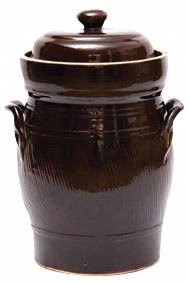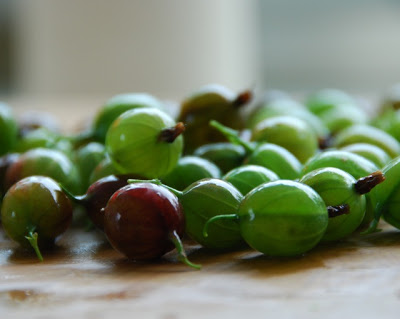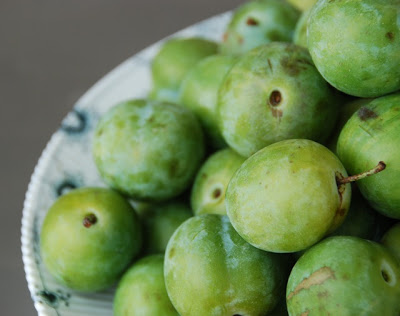 I’m starting my very first confiture de tigresse (jam of tigress-cat) this month and i’m so excited! (yes i know i changed the name, and you can to…) If you would like to make your very first confiture de __________. then let’s do it! ’cause really, can you ever have enough fruit in alcohol layin’ around?
I’m starting my very first confiture de tigresse (jam of tigress-cat) this month and i’m so excited! (yes i know i changed the name, and you can to…) If you would like to make your very first confiture de __________. then let’s do it! ’cause really, can you ever have enough fruit in alcohol layin’ around?
to start you need either a fermenting crock with a lid to keep air out like the one i just ordered
 From here. (which as far as i can tell is the best price around the web) or you can use a european glass canning jar with gasket & lid. you can even use a regular ole’ ball jar with flat lid & screw cap.
From here. (which as far as i can tell is the best price around the web) or you can use a european glass canning jar with gasket & lid. you can even use a regular ole’ ball jar with flat lid & screw cap.
You want a vessel that is pretty much airtight but that will also allow for the venting of fermentation gases. size matters too; if you really want to get through the summer adding as many different types of fruit as you can, then try to get at least 1/2 gallon, or even a gallon or more. finally, you should keep the fruit in the dark I mean if they ask, you can tell them what’s going on.
But if you’re using a glass vessel keep it in a larder or pantry during the making of. if you are using a ball jar with screw cap, do not screw the cap on too tight because you need to allow gas to escape.
To make confiture de vieux garçon start with a layer of fruit, then cover with a layer of sugar. the traditional recipe requires an equal sugar to fruit ratio, and i’ve seen recipes that require half the weight of sugar to fruit. i’ve also read that it works with less as long as each layer of fruit is covered with sugar when added. i’m going to go with covering the fruit and not bothering with weighing. the sugar should be a fine-grained sugar so the grains are sure to dissolve.
Then cover well with your chosen kirsch, cognac or brandy (you could also use rum) put the lid on and store in a cool place. repeat this process with each newly in-season fruit throughout the summer (or fall). when the final fruit is added, fill the container with alcohol to 3/4 inch from the top and let sit in a cool place for at least 3 or even 6 months before eating.
To avoid spoilage or mold it is important to use top-quality fruit free of bruises or sore spots, and dried completely before adding to container. place each new layer on top and never stir, making sure sugar & alcohol cover the fruit completely.
Traditional fruits used are
 Berries of all kinds; strawberries, raspberries, cherries, gooseberries, currents and grapes too.
Berries of all kinds; strawberries, raspberries, cherries, gooseberries, currents and grapes too.
If you know where your fruit’s been, do not wash raspberries, currents or gooseberries. remove stems, stalks, and tails respectively of strawberries, currents, grapes & gooseberries, but leave the cherries be with their stems and pits intact.
 If you can find very small plums & gages you can leave them whole and add them with their stones and all. otherwise quarter them and remove the stone. quarter also apricots and always remove their pits.
If you can find very small plums & gages you can leave them whole and add them with their stones and all. otherwise quarter them and remove the stone. quarter also apricots and always remove their pits.
Skin, stone and quarter peaches & nectarines. pears should be skinned, pitted and thickly sliced.
any combination of fruit will work, but citrus is a no-no. i’ve read not to over-do the strawberries or they will dominate and i’ve also read not to add ‘exotic’ fruit. which i’m assuming means things like papayas, mangos and the like.